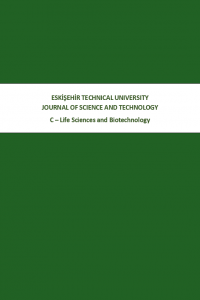DOĞU AKDENİZ SEDİMANLARINDAN İZOLE EDİLEN BAKTERİLERİN FİLOGENETİK ÇEŞİTLİLİĞİ VE ANTİBİYOTİK DİRENÇLİLİĞİ
Bakteri filogenetiği, 16S rRNA genleri, Antibiyotik duyarlılık, Akdeniz
PHYLOGENETIC DIVERSITY AND ANTIBIOTIC RESISTANCE OF BACTERIA ISOLATED FROM SEDIMENTS OF EASTERN MEDITERRANEAN SEA
___
- [1] Giovannoni S, Rappe M. Evolution, diversity and molecular ecology of marine prokaryotes. In: Kirchman DL, editor. Microbial ecology oft he oceans. New York: Wiley-Liss Inc, 2000, pp. 47-84.
- [2] Hagström A, Pommier T, Rowher F, Simu K, Stolte W, Svensonn D, et al. Use of 16S ribosomal DNA for delination of marine bacterioplankton species. Appl Env Microbiol 2002; 68: 3628–3633.
- [3] McIntyre A. A global census of marine microbes. In: McIntyre A, editor. Life in the world’s oceans: diversity, distribution and abundance. NewYork: Wiley-Blackwell, 2010.
- [4] Kummerer K. Antibiotics in the aquatic environment – A review – Part I. Chemosphere 2009; 75: 417–434.
- [5] Kummerer K. Antibiotics in the aquatic environment – A review – Part II. Chemosphere 2009; 75: 435–441.
- [6] Tanhua T, Hainbucher D, Shröder K, Cardin V, Alvaez M, Civitarese G. The Mediterranean Sea system: a review and an introduction to the special issue. Ocean Sci Discuss 2013; 10: 581–617.
- [7] Mincer TJ, Jensen PR, Kauffman CA, Fenical W. Widespread and persistent populations of a major new marine actinomycete taxon in ocean sediments. Appl Env Microbiol 2002; 68: 5005–5011.
- [8] Gontag EA, Fenical W, Jensen PR. Phylogenetic diversity of Gram-positive bacteria cultured from marine sediments. Appl Env Microbiol 2007; 73 (10): 3272–3282.
- [9] Hayakawa M, Sadaka T, Kayiura T, Nonomura H. New methods for the highly selective isolation Micromonospora and Microbispora. J Ferment Bioeng 1991; 72: 320-326.
- [10] Galatenko OA, Terekhova LP. Isolation of antibiotic-producing actinomycetes from soil samples exposed to UV-light. Antibiotic I Khimioter 1990; 11: 6–8.
- [11] Tamura K, Peterson D, Peterson N, Stecher G, Nei M, Kumar S. MEGA5: Molecular Evolutionary Genetics Analysis using maximum likelihood, evolutionary distance, and maximum parsimony methods. Mol Biol Evol 2011; 28: 2731–2739.
- [12] Clinical Laboratory Standards Institute (CLSI). Performance standards for antimicrobial disk susceptibility tests; approved standard – eleventh edition. Wayne, Pennsylvania, USA, 2012.
- [13] Stackebrandt E, Ebers J. Taxonomic parameters revisited: tarnished gold standards. Microbiol Today 2006; 33: 152–155.
- [14] Polymenakou PN, Lampadariou N, Mandalakis M, Tselepides A. Phylogenetic diversity of sediment bacteria from the southern Cretan margin, Eastern Mediterranean Sea. Syst Appl Microbiol 2009; 32: 17–26.
- [15] Kouridaki I, Polymenakou PN, Tselepides A, Mandalakis M, Smith KL. Phylogenetic diversity of sediment bacteria from deep Norteastern Pacific Ocean: a comparison with the deep Eastern Mediterranean Sea. Int Microbiol 2010; 13: 143–150.
- [16] Gärtner A, Blümel M, Wiese J, Imhoff JF. Isolation and characterization of bacteria from the Eastern Mediterranean deep sea. Antonie Leeuwenhoek 2011; 100: 421–435.
- [17] Altug G, Cardak M, Ciftci PS, Gurun S, Saad AA, Ibrahim A, Fakhri M. Distribution and antibiotic resistance of heterotrophic and indicator bacteria in the coastal areas of Turkey, Syria and Lebanon. Rapp Comm Int mer Medit 2010; 39: 333.
- [18] Akkan T, Kaya A, Dincer S. Antibiotic levels and heavy metal resistance in Gram-negative bacteria isolated from seawater, Iskenderun Organized Industrial Zone. JABS 2013; 7 (1): 10–14.
- [19] Sivri N, Ozbayram G, Karatut Z. Antibiotic resistance of enteric bacteria isolated from south-western Istanbul coast (Turkey). Rapp Comm Int mer Medit 2010; 39: 402.
- [20] Kimiran-Erdem A, Arslan EO, Yurudu NOS, Zeybek Z, Dogruoz N, Cotuk A. Isolation and identification of Enterococci from seawater samples: Assessment of their resistance to antibiotics and heavy metals. Environ Monit Assess 2007; 125: 219–228.
- [21] Cardak M, Altuğ G, Ay M, Erol O. Distribution of antibiotic resistance and the presence of vancomycin-resistance genes (vanA and vanB) in Enterobacteriaceae isolated from the Sea of Marmara, the Canakkale Strait and the Istanbul Strait, Turkey. Oceanol Hydrobiol St 2016; 45 (2): 182–190.
- ISSN: 2667-4203
- Yayın Aralığı: Yılda 2 Sayı
- Başlangıç: 2010
- Yayıncı: Eskişehir Teknik Üniversitesi
FİTOPATOJEN BAKTERİLERE AİT SALGI SİSTEMLERİNİN GENEL ÖZELLİKLERİ
PHENOLIC COMPOUNDS DETERMINATION AND ANTIOXIDANT ACTIVITY OF TEUCRIUM CAVERNARUM
Fatih GÖĞER, Ayla KAYA, Muhittin DİNÇ, Süleyman Doğu DOĞU
Tuğça BİLENLER, İhsan KARABULUT
THE EFFECT OF DRAG FORCE AND FLOW RATE ON MESENCHYMAL STEM CELLS IN PACKED-BED PERFUSION BIOREACTOR
GENO-SİTOTOKSİSİTE ÇALIŞMALARINA SİTOM YAKLAŞIMI
BISBENZOXAZOLE DERIVATIVES HAD ANTI-PROLIFERATIVE EFFECT ON HUMAN CANCER CELLS
Furkan AYAZ, Qadar Ahmed ISSE, Rusmeenee KHEEREE, Ronak Haj ERSAN, Oztekin ALGUL
